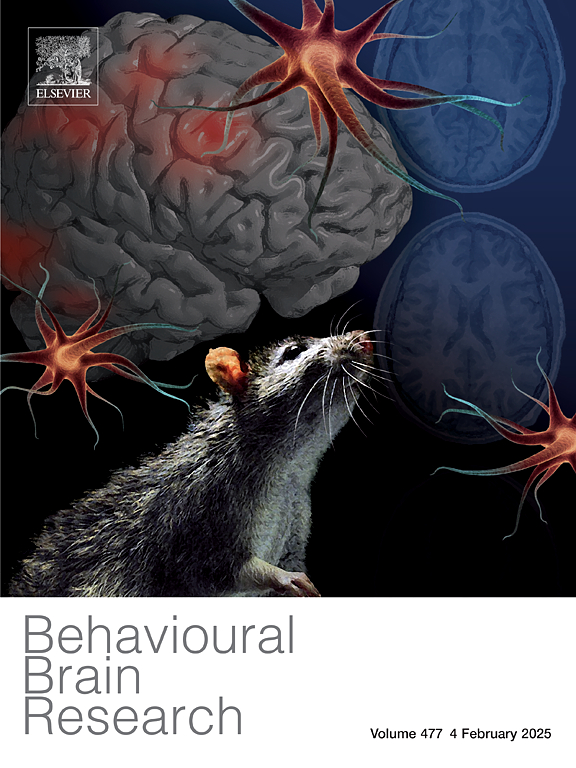adgrl3.1 knockout disrupts cortisol regulation and stress reactivity, linking externalizing and internalizing behaviors
IF 2.6
3区 心理学
Q2 BEHAVIORAL SCIENCES
引用次数: 0
Abstract
The adhesion G protein-coupled receptor L3 (ADGRL3) protein has been implicated in various externalizing disorders (EDs), including ADHD and substance abuse disorder. Previous work has shown that zebrafish with a homozygous knockout of adgrl3.1 (adgrl3.1-/-) not only show altered externalizing behaviors, but also altered internalizing behaviors, such as anxiety. Here, we aimed to understand the functional significance of adgrl3.1 across both externalizing and internalizing behaviors, to understand if there was an intrinsic link between externalizing disorders and comorbid internalizing symptoms. To further understand the role of this gene in anxiety and stress reactivity, we investigated the behavioral and physiological responses of adgrl3.1 knockouts to several anxiety-related behavioral tasks, and when challenged with an acute stressor, conspecific alarm substance (CAS). This included measuring stress-related markers both at baseline and during stress, including cortisol levels and expression of the genes bdnf and gr. We found that adgrl3.1-/- exhibited increase in bottom-dwelling in the novel tank diving test and greater preference for the dark zone in the light/dark task, both indicative of heightened anxiety-like behavior. These animals also showed a disrupted stress response, characterized by lower baseline cortisol levels together with increased cortisol response to CAS. adgrl3.1-/- also exhibited increased repetitions in the FMP Y-maze, which, when combined with stress, reflected a shift toward more rigid behavioral strategies and impaired cognitive flexibility. Our findings suggest that the adgrl3.1 gene plays an important role in regulating stress reactivity and cognitive function. Overall, our study provides novel evidence of the functional significance of adgrl3.1 in both externalizing and internalizing behaviors, particularly via its role in modulating physiological responses to stress.
Adgrl3.1基因敲除破坏皮质醇调节和应激反应,将外化和内化行为联系起来
黏附G蛋白偶联受体L3 (ADGRL3)蛋白与多种外化障碍(EDs)有关,包括ADHD和药物滥用障碍。先前的研究表明,纯合敲除adgrl3.1 (adgrl3.1-/-)的斑马鱼不仅表现出外化行为的改变,而且还表现出内化行为的改变,如焦虑。在这里,我们的目的是了解adgrl3.1在外化和内化行为中的功能意义,了解外化障碍和共病内化症状之间是否存在内在联系。为了进一步了解该基因在焦虑和应激反应中的作用,我们研究了adgrl3.1基因敲除对几种与焦虑相关的行为任务的行为和生理反应,以及在急性应激源、同特异性报警物质(CAS)的挑战下的行为和生理反应。这包括在基线和压力期间测量与压力相关的标记,包括皮质醇水平和基因bdnf和gr的表达。我们发现adgrl3.1-/-在新的水箱潜水测试中表现出底部居住的增加,并且在光/暗任务中更倾向于暗区,这两者都表明了焦虑样行为的增加。这些动物也表现出紊乱的应激反应,其特征是较低的基线皮质醇水平以及对CAS的皮质醇反应增加。adgrl3.1-/-在FMP y迷宫中也表现出增加的重复,当与压力相结合时,反映了向更严格的行为策略和认知灵活性受损的转变。我们的研究结果表明,adgrl3.1基因在调节应激反应和认知功能中起着重要作用。总的来说,我们的研究为adgrl3.1在外化和内化行为中的功能意义提供了新的证据,特别是通过它在调节应激生理反应中的作用。
本文章由计算机程序翻译,如有差异,请以英文原文为准。
求助全文
约1分钟内获得全文
求助全文
来源期刊

Behavioural Brain Research
医学-行为科学
CiteScore
5.60
自引率
0.00%
发文量
383
审稿时长
61 days
期刊介绍:
Behavioural Brain Research is an international, interdisciplinary journal dedicated to the publication of articles in the field of behavioural neuroscience, broadly defined. Contributions from the entire range of disciplines that comprise the neurosciences, behavioural sciences or cognitive sciences are appropriate, as long as the goal is to delineate the neural mechanisms underlying behaviour. Thus, studies may range from neurophysiological, neuroanatomical, neurochemical or neuropharmacological analysis of brain-behaviour relations, including the use of molecular genetic or behavioural genetic approaches, to studies that involve the use of brain imaging techniques, to neuroethological studies. Reports of original research, of major methodological advances, or of novel conceptual approaches are all encouraged. The journal will also consider critical reviews on selected topics.
 求助内容:
求助内容: 应助结果提醒方式:
应助结果提醒方式:


